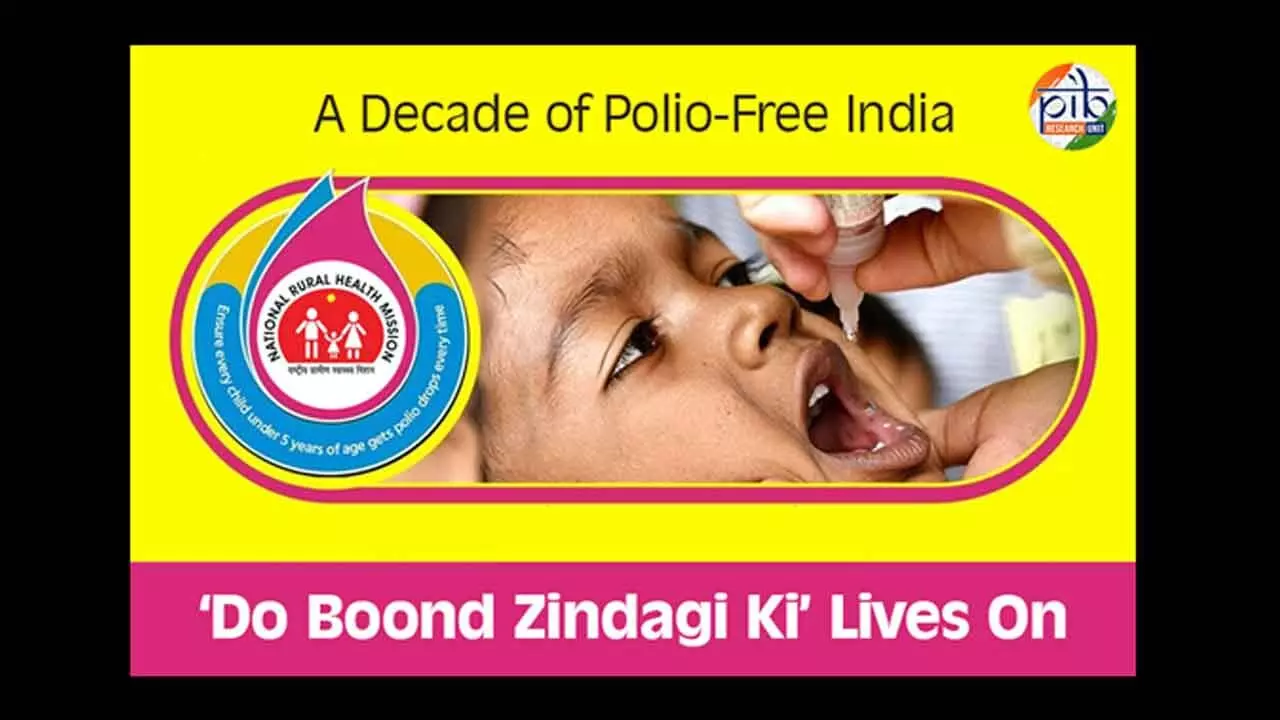Live
- Trump Demands Panama Canal Return, Criticises Panama's Management and Fees
- PV Sindhu Marries Venkata Datta Sai in a Grand Ceremony in Udaipur
- Not satisfied, I want more: De Minaur sets sights on plenty of goals in 2025
- Upset over exclusion from cabinet, Bhujbal meets CM Fadnavis over 'growing' OBC resentment
- Australia prepares for catastrophic bushfire over Christmas period
- Global prevalence of atopic dermatitis to reach 42.42 mn by 2033: Report
- OpenAI's GPT 5 Faces Delays Amid Data and Financial Challenges
- Sunny Leone's Name Used in Fraud Under Chhattisgarh’s Mahtari Vandan Yojana
- Gold Business Fraud Uncovered in Atmakur, Wanaparthy
- Rachakonda Police Seize Rs.88 Crore Worth Drugs, Arrest 521 Accused
Just In
Zero Case: A Saga of Eradication of Polio in India


One key factor behind India’s polio eradication success was the unwavering political will demonstrated by the central and the state governments....
One key factor behind India’s polio eradication success was the unwavering political will demonstrated by the central and the state governments. Political leaders at all levels provided consistent support, ensuring that resources were allocated and the program received the needed attention
India’s achievement of polio-free status in 2014 represents one of the most significant successes in global public health. The eradication of polio was not a singular event, but the culmination of decades of dedicated efforts, starting with India’s participation in the Global Polio Eradication Initiative (GPEI) and complemented by the robust national immunization efforts under the Universal Immunization Programme (UIP).
The strategic integration of new vaccines, innovative surveillance systems, and government-led immunization campaigns played a crucial role in making India polio-free. This achievement was made possible through the tireless efforts of the Government of India in partnership with key global organizations, including UNICEF, the World Health Organization (WHO), the Bill & Melinda Gates Foundation, Rotary International, and the Center for Disease Control and Prevention (CDC). Together, they mobilized resources, provided technical expertise, and created widespread public awareness about the critical need to vaccinate every child under five against polio.
India’s immunization efforts can be traced back to 1978, when the Expanded Programme on Immunization (EPI) was launched. This programme aimed to provide vaccines to children against various diseases. In 1985, this programme was renamed the Universal Immunization Programme (UIP), broadening its reach to rural areas beyond urban centers. Over time, the UIP became an integral part of several national health initiatives, including the National Rural Health Mission (NRHM), launched in 2005 to improve the health of rural populations.
Today, UIP is one of the world’s largest public health programs, targeting over 2.67 crore newborns and 2.9 crore pregnant women annually, providing free vaccines for 12 vaccine-preventable diseases. Polio was one of the first diseases targeted under UIP, and its elimination became a key public health milestone.
India’s fight against polio took a significant step forward in 1995 with the launch of the Pulse Polio Immunization Programme. The first large-scale vaccination campaign, held on 2nd October 1994 (Gandhi Jayanti) in Delhi, was the precursor to the national Pulse Polio campaign. The campaign used an Oral Polio Vaccine (OPV) strategy, reaching over 1 million children and ensuring every child under five was vaccinated. This model was subsequently scaled up nationwide.
The campaign became iconic, with the slogan “Do Boond Zindagi Ki” (Two drops of life) becoming synonymous with India’s efforts to eliminate polio.
In line with the Global Polio Endgame Strategy, India introduced the Inactivated Polio Vaccine (IPV) in 2015 as part of its commitment to polio eradication. IPV provides additional protection against polio, especially against type 2 poliovirus, and was gradually introduced in six states before being expanded nationwide by 2016. This switch was essential after the global shift from trivalent OPV (tOPV) to bivalent OPV (bOPV), which excludes the type 2 strain, and IPV ensured continued protection.
Add to these efforts, the continued focus on surveillance helped India detect and respond to any potential outbreaks quickly. One key factor behind India’s polio eradication success was the unwavering political will demonstrated by the central and the state governments. Political leaders at all levels provided consistent support, ensuring that resources were allocated and the program received the needed attention.
In addition to IPV, India has introduced several new vaccines under its immunization programme, including Rotavirus, Pneumococcal Conjugate Vaccine (PCV), and Measles-Rubella (MR) vaccine, as part of broader efforts to prevent other vaccine-preventable diseases.
Mission Indradhanush: Launched in 2014, Mission Indradhanush (MI) aims to increase immunization coverage to 90%. Special attention is given to hard-to-reach areas with low immunization rates. In its Intensified Mission Indradhanush phase, the programme has significantly increased immunization coverage, further reinforcing India’s commitment to child health.

© 2024 Hyderabad Media House Limited/The Hans India. All rights reserved. Powered by hocalwire.com






